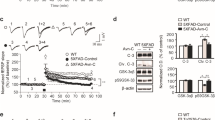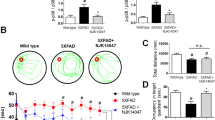Abstract
A high co-morbidity between Alzheimer’s disease (AD) and depression suggests there might be similar mechanisms underlying the course of these diseases. Previous studies have shown that p38MAPK plays a critical role in the pathophysiology of AD and depression. However, little is known about whether SB203580, a selective inhibitor of p38MAPK, may protect against AD-associated cognitive impairments and depression-like behavior, simultaneously. Herein, we have shown, for the first time, that SB203580 may reverse memory impairments and depression-like behavior induced by hippocampal infusion of β-amyloid 1–42 (Aβ1–42), as measured by novel object recognition, Morris water maze, tail-suspension and forced-swimming tests. In addition, phorbol 12-myristate 13-acetate (PMA), a PKC activator which also activates p38MAPK, significantly abolished the effects of SB203580. Moreover, Aβ1–42 causes increased phosphorylation of p38MAPK and decreased phosphorylation of Ser9-glycogen synthase kinase 3β (GSK3β) and cAMP-response element binding protein (CREB) in the hippocampus of mice, which could be significantly reversed by SB203580. Our results suggest that SB203580 reversed Aβ1–42-induced cognitive impairments and depression-like behavior via inhibiting p38MAPK signaling pathway, which not only supports p38MAPK as a therapeutic target for AD-associated cognitive dysfunction and depression-like behavior, but also provides experimental basis for the use of SB203580 in co-morbidity of AD and depression.








Similar content being viewed by others
References
Alimohamad H, Rajakumar N, Seah YH, Rushlow W (2005) Antipsychotics alter the protein expression levels of beta-catenin and GSK-3 in the rat medial prefrontal cortex and striatum. Biol Psychiatry 57:533–542
Ali T, Yoon GH, Shah SA, Lee HY, Kim MO (2015) Osmotin attenuates amyloid beta-induced memory impairment, tau phosphorylation and neurodegeneration in the mouse hippocampus. Sci Rep 5:11708
Al-Lahham R, Deford JH, Papaconstantinou J (2016) Mitochondrial-generated ROS down regulates insulin signaling via activation of the p38MAPK stress response pathway. Mol Cell Endocrinol 419:1–11
Budson AE, Price BH (2005) Memory dysfunction. N Engl J Med 352:692–699
Chen X, Lin R, Chang L, Xu S, Wei X, Zhang J, Wang C, Anwyl R, Wang Q (2013) Enhancement of long-term depression by amyloid β protein in rat hippocampus is mediated by metabotropic glutamate receptor and involves activation of p38 MAPK, STEP and caspase-3. Neuroscience 253:435–443
Embi N, Rylatt DB, Cohen P (1980) Glycogen synthase kinase-3 from rabbit skeletal muscle. Separation from cyclic-AMP-dependent protein kinase and phosphorylase kinase. Eur J Biochem 107:519–527
Feijoo C, Campbell DG, Jakes R, Goedert M, Cuenda A (2005) Evidence that phosphorylation of the microtubule-associated protein Tau by SAPK4/p38delta at Thr50 promotes microtubule assembly. J Cell Sci 118:397–408
Ferrer I, Barrachina M, Puig B (2002) Glycogen synthase kinase-3 is associated with neuronal and glial hyperphosphorylated tau deposits in Alzheimer’s disease, Pick’s disease, Progressive supranuclear palsy and corticobasal degeneration. Acta Neuropathol 104:583–591
Galeotti N, Ghelardini C (2012) Selective modulation of the PKCε/p38MAP kinase signalling pathway for the antidepressant-like activity of amitriptyline. Neuropharmacology 62:289–296
Grassme H, Jernigan PL, Hoehn RS, Wilker B, Soddemann M, Edwards MJ, Muller CP, Kornhuber J, Gulbins E (2015) Inhibition of Acid Sphingomyelinase by Antidepressants Counteracts Stress-Induced Activation of P38-Kinase in Major Depression. Neurosignals 23:84–92
Godyń J, Jończyk J, Panek D, Malawska B (2016) Therapeutic strategies for Alzheimer’s disease in clinical trials. Pharmacol Rep 68:127–138
Goedert M, Hasegawa M, Jakes R, Lawler S, Cuenda A, Cohen P (1997) Phosphorylation of microtubule-associated protein tau by stress-activated protein kinases. FEBS Lett 409:57–62
Goltser-Dubner T, Galili-Weisstub E, Segman RH (2010) Genetics of unipolar major depressive disorder. Isr J Psychiatry Relat Sci 47:72–82
Harrington KD, Gould E, Lim YY, Ames D, Pietrzak RH, Rembach A, Rainey-Smith S, Martins RN, Salvado O, Villemagne VL, Rowe CC, Masters CL, Maruff P; AIBL Research Group (2016) Amyloid burden and incident depressive symptoms in cognitively normal older adults. Int J Geriatr Psychiatry doi:10.1002/gps.4489.
Johnson LA, Gamboa A, Vintimilla R, Cheatwood AJ, Grant A, Trivedi A, Edwards M, Hall JR, O’Bryant SE (2015) Comorbid depression and diabetes as a risk for mild cognitive impairment and Alzheimer’s disease in elderly Mexican Americans. J Alzheimers Dis 47:129–136
Kim MH, Leem YH (2014) Chronic exercise improves repeated restraint stress-induced anxiety and depression through 5HT1A receptor and cAMP signaling in hippocampus. J Exerc Nutrition Biochem. 2014 Mar;18(1):97–104.
Kurup P, Zhang Y, Xu J, Venkitaramani DV, Haroutunian V, Greengard P, Nairn AC, Lombroso PJ (2010) Abeta-mediated NMDA receptor endocytosis in Alzheimer’s disease involves ubiquitination of the tyrosine phosphatase STEP. J Neurosci 30:5948–5957
Li YF, Cheng YF, Huang Y, Conti M, Wilson SP, O’Donnell JM, Zhang HT (2011) Phosphodiesterase-4D knock-out and RNA interference-mediated knock-down enhance memory and increase hippocampal neurogenesis via increased cAMP signaling. J Neurosci 31:172–183
Li YF, Huang Y, Amsdell SL, Xiao L, O’Donnell JM, Zhang HT (2009) Antidepressant- and anxiolytic-like effects of the phosphodiesterase-4 inhibitor rolipram on behavior depend on cyclic AMP response element binding protein-mediated neurogenesis in the hippocampus. Neuropsychopharmacology 34:2404–2419
Lochhead PA, Kinstrie R, Sibbet G, Rawjee T, Morrice N, Cleghon V (2006) A chaperone-dependent GSK3beta transitional intermediate mediates activation-loop autophosphorylation. Mol Cell 24:627–633
Lueptow LM, Zhan CG, O’Donnell JM (2015) Cyclic GMP-mediated memory enhancement in the object recognition test by inhibitors of phosphodiesterase-2 in mice. Psychopharmacology 233:447–456
Martín-Hernández D, Caso JR, Bris ÁG, Maus SR, Madrigal JL, García-Bueno B, MacDowell KS, Alou L, Gómez-Lus ML, Leza JC (2016) Bacterial translocation affects intracellular neuroinflammatory pathways in a depression-like model in rats. Neuropharmacology 103:122–133
Masvekar RR, El-Hage N, Hauser KF, Knapp PE (2015) GSK3β-activation is a point of convergence for HIV-1 and opiate-mediated interactive neurotoxicity. Mol Cell Neurosci 65:11–20
Milić M, Timić T, Joksimović S, Biawat P, Rallapalli S, Divljaković J, Radulović T, Cook JM, Savić MM (2013) PWZ-029, an inverse agonist selective for α5 GABAA receptors, Improves object recognition, but not water-maze memory in normal and scopolamine-treated rats. Behav Brain Res 241:206–213
Nemeroff CB (2007) Stress, menopause and vulnerability for psychiatric illness. Expert Rev Neurother 7:S11–S13
Ortega-Martínez S (2015) A new perspective on the role of the CREB family of transcription factors in memory consolidation via adult hippocampal neurogenesis. Front Mol Neurosci 8:46
Page ME, Detke MJ, Dalvi A, Kirby LG, Lucki I (1999) Serotonergic mediation of the effects of fluoxetine, but not desipramine, in the rat forced swimming test. Psychopharmacology 147:162–167
Pandey GN, Dwivedi Y, Rizavi HS, Teppen T, Gaszner GL, Roberts RC, Conley RR (2009) GSK-3beta gene expression in human postmortem brain: regional distribution, effects of age and suicide. Neurochem Res 34:274–285
Papazoglou IK, Jean A, Gertler A, Taouis M, Vacher CM (2015) Hippocampal GSK3β as a Molecular Link Between Obesity and Depression. Mol Neurobiol 52:363–374
Paul S, Connor JA (2010) NR2B-NMDA receptor-mediated increases in intracellular Ca2+ concentration regulate the tyrosine phosphatase, STEP, And ERK MAP kinase signaling. J Neurochem 114:1107–1118
Perez-Costas E, Gandy JC, Melendez-Ferro M, Roberts RC, Bijur GN (2010) Light and electron microscopy study of glycogen synthase kinase-3beta in the mouse brain. PLoS One 5(1):e8911
Pláteník J, Fišar Z, Buchal R, Jirák R, Kitzlerová E, Zvěřová M, Raboch J (2014) GSK3β, CREB, And BDNF in peripheral blood of patients with Alzheimer’s disease and depression. Prog Neuro-Psychopharmacol Biol Psychiatry 50:83–93
Pomara N, Doraiswamy PM, Willoughby LM, Roth AE, Mulsant BH, Sidtis JJ, Mehta PD, Reynolds CF 3rd, Pollock BG (2006) Elevation in plasma Abeta42 in geriatric depression: a pilot study. Neurochem Res 31:341–349
Rosa E, Fahnestock M (2015) CREB expression mediates amyloid β-induced basal BDNF downregulation. Neurobiol Aging 36:2406–2413
Roy SM, Grum-Tokars VL, Schavocky JP, Saeed F, Staniszewski A, Teich AF, Arancio O, Bachstetter AD, Webster SJ, Van Eldik LJ, Minasov G, Anderson WF, Pelletier JC, Watterson DM (2015) Targeting human central nervous system protein kinases: An isoform selective p38αMAPK inhibitor that attenuates disease progression in Alzheimer’s disease mouse models. ACS Chem Neurosci 6:666–680
Sahara N, Vega IE, Ishizawa T, Lewis J, McGowan E, Hutton M, Dickson D, Yen SH (2004) Phosphorylated p38MAPK specific antibodies cross-react with sarkosyl-in hyperphosphorylated tau proteins. J Neurochem 90:829–938
Sanderson TM, Hogg EL, Collingridge GL, Corrêa SA (2016) Hippocampal mGluR-LTD in health and disease: focus on the p38 MAPK and ERK1/2 pathways. J Neurochem doi: 10.1111/jnc.13592
Selkoe DJ (2002) Alzheimer’s disease is a synaptic failure, vol 298. Science, pp. 789–791
Severino G, Squassina A, Costa M, Pisanu C, Calza S, Alda M, Del Zompo M, Manchia M (2013) Pharmacogenomics of bipolar disorder. Pharmacogenomics 14:655–674
Small DH, Mok SS, Bornstein JC (2001) Alzheimer’s disease and Atoxicity: from top to bottom. Nat Rev Neurosci 8:595–598
Sutherland C, Cohen P (1994) The alpha-isoform of glycogen synthase kinase-3 from rabbit skeletal muscle is inactivated by p70 S6 kinase or MAP kinase-activated protein kinase-1 in vitro. FEBS Lett 338:37–42
Tang Y, Peng Y, Liu J, Shi L, Wang Y, Long J, Liu J (2015) Early inflammation-associated factors blunt sterol regulatory element-binding proteins-1-mediated lipogenesis in high-fat diet-fed APPSWE/PSEN1dE9 mouse model of Alzheimer’s disease. J Neurochem doi:10.1111/jnc.13437
Terry R, Peck A, DeTeresa R, Schechter R, Horoupian D (1981) Some morphometric aspects of the brain in senile dementia of the Alzheimer type. Ann Neurol 10:184–192
Tran TT, Srivareerat M, Alhaider IA, Alkadhi KA (2011) Chronic psychosocial stress enhances long-term depression in a subthreshold amyloid-beta rat model of Alzheimer’s disease. J Neurochem 119:408–416
Watson C, Paxinos G (2010) Chemoarchitectonic Atlas of the Mouse Brain. San Diego. Elsevier Academic Press
Wang C, Yang XM, Zhuo YY, Zhou H, Lin HB, Cheng YF, JP X, Zhang HT (2012) The phosphodiesterase-4 inhibitor rolipram reverses Aβ-induced cognitive impairment and neuroinflammatory and apoptotic responses in rats. Int J Neuropsychopharmacol 15:749–766
Wang ZZ, Zhang Y, Liu YQ, Zhao N, Zhang YZ, Yuan L, An L, Li J, Wang XY, Qin JJ, Wilson SP, O’Donnell JM, Zhang HT, Li YF (2013) RNA interference-mediated phosphodiesterase 4D splice variants knock-down in the prefrontal cortex produces antidepressant-like and cognition-enhancing effects. Br J Pharmacol 168:1001–1014
Woodgett JR (1990) Molecular cloning and expression of glycogen synthase kinase-3/factor a. EMBO J 9:2431–2438
Xu J, Kurup P, Zhang Y, Goebel-Goody SM, PH W, Hawasli AH, Baum ML, Bibb JA, Lombroso PJ (2009) Extrasynaptic NMDA Receptors Couple Preferentially to Excitotoxicity via Calpain-Mediated Cleavage of STEP. J Neurosci 29:9330–9343
Xu Y, Cao DH, GM W, Hou XY (2014) Involvement of P38MAPK activation by NMDA receptors and non-NMDA receptors in amyloid-β peptide-induced neuronal loss in rat hippocampal CA1 and CA3 subfields. Neurosci Res 85:51–57
Zhang D, Guo M, Zhang W, Lu XY (2011) Adiponectin stimulates proliferation of adult hippocampal neural stem/progenitor cells through activation of p38 mitogen-activated protein kinase (p38MAPK)/glycogen synthase kinase 3β (GSK-3β)/β-catenin signaling cascade. J Biol Chem 286:44913–44920
Zhang R, Miller RG, Madison C, Jin X, Honrada R, Harris W, Katz J, Forshew DA, McGrath MS (2013) Systemic immune system alterations in early stages of Alzheimer’s disease. J Neuroimmunol 256:38–42
Zhang Y, Kurup P, Xu J, Carty N, Fernandez SM, Nygaard HB, Pittenger C, Greengard P, Strittmatter SM, Nairn AC, Lombroso PJ (2010) Genetic reduction of striatal-enriched tyrosine phosphatase (STEP) reverses cognitive and cellular deficits in an Alzheimer’s disease mouse model. Proc Natl Acad Sci U S A 107:19014–19019
Zhu X, Rottkamp CA, Hartzler A, Sun Z, Takeda A, Boux H, Shimohama S, Perry G, Smith MA (2001) Activation of MKK6, an upstream activator of p38, in Alzheimer’s disease. J Neurochem 79:311–318
Acknowledgments
This work was supported by National Natural Science Foundation of China (No. 81201050; No.81271209; U1503223); Natural Science Foundation of Zhejiang Province (No.LQ12H09001); Natural Science Foundation of Ningbo (No. 2012 A610249);Ningbo municipal innovation team of life science and health (2015C110026). This project also sponsored by K.C. Wong Magna funded at Ningbo University.
Author information
Authors and Affiliations
Corresponding authors
Ethics declarations
Conflict of interest
The authors declare no conflict of interest.
Rights and permissions
About this article
Cite this article
Guo, J., Chang, L., Li, C. et al. SB203580 reverses memory deficits and depression-like behavior induced by microinjection of Aβ1–42 into hippocampus of mice. Metab Brain Dis 32, 57–68 (2017). https://doi.org/10.1007/s11011-016-9880-4
Received:
Accepted:
Published:
Issue Date:
DOI: https://doi.org/10.1007/s11011-016-9880-4




